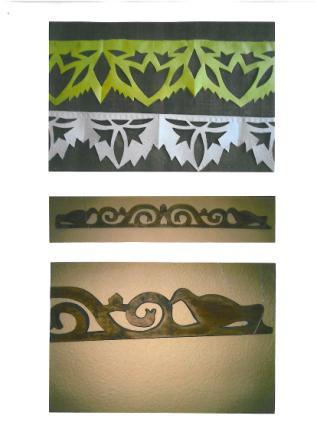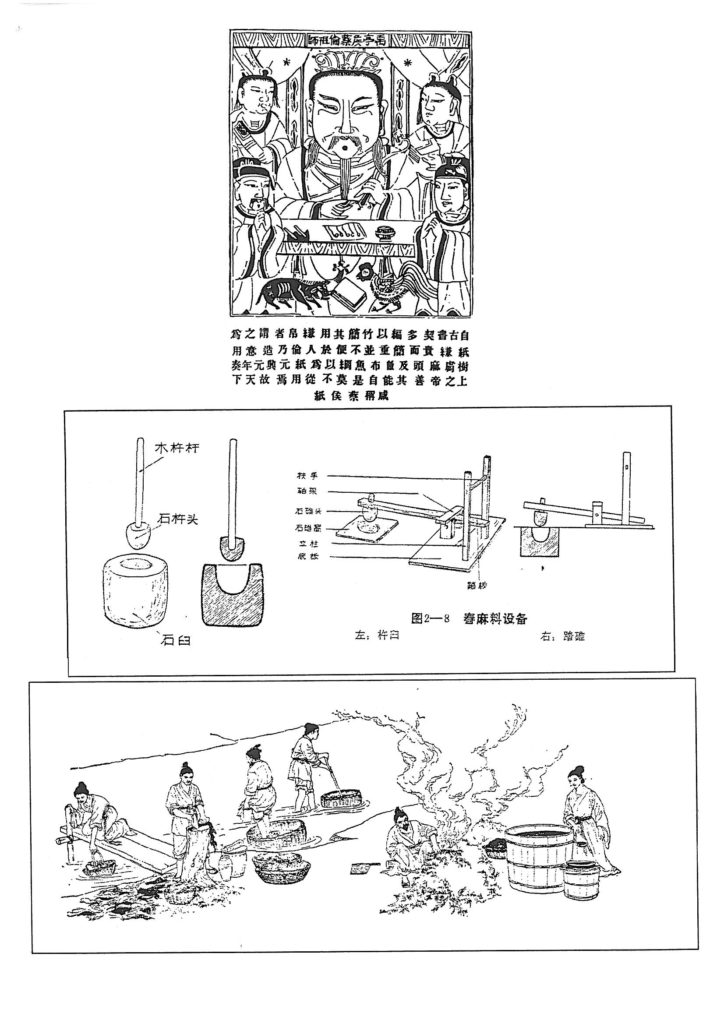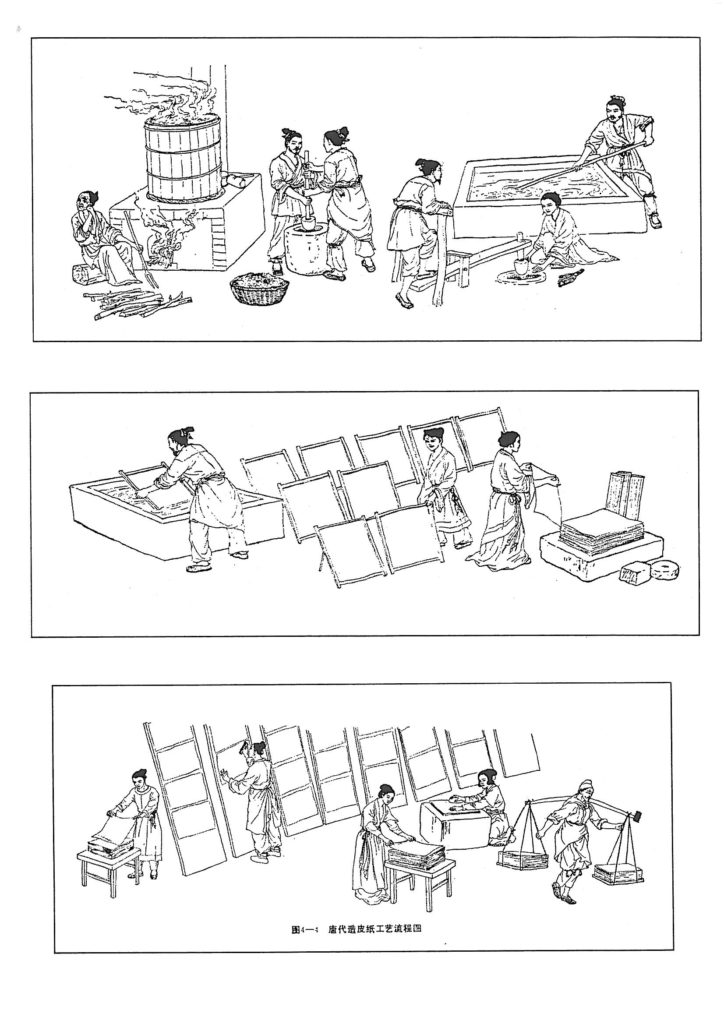Paper cuttings
Paper cuttings are an original branch of art, many unique works of which have been created by painters, folk and other artists. Two thousand years old origins of the paper cuttings we find in the East. Silhouette paper cuttings found their way from Persia to Europe in the 17th century. Soon they spread in Spain, Denmark, France, German…
In Lithuania and Poland the art of paper cutting took a spontaneous way of development – as a branch of applied arts. Paper cuttings were especially popular in the country. Before Christmas, on wedding-party and other occasions people used to decorate their rooms, windows, lamps and frames of holy pictures with cutout starlets, flowers and blinds.
Ornamentations of perforated paper cuttings were greatly influenced by specific and compositional traditions of cloth and wood carving patterns. Paper cuttings reflected the unique character of folk art and ethnic culture of certain region.
At the second half of the 20th century paper cuttings in Lithuania started disappearing. Occasionally, they were used to decorate coffin brims, napkins in the cupboards and wardrobes. It was in the towns and cities that paper cuttings began to revive. J.Daniliauskiene brought them back from obscurity, made them serve another purpose, and thus gained lots of successors.
Now patterns and composition of paper cuttings are being developed, making use of the heritage of folk art and folklore, expressed through symbolical realities. It took three decades to form a new art of paper cuttings, very similar to graphics art and applied to new living conditions. It is pictures and post cards, exlibrises and book illustrations. Both, symmetrical and asymmetrical composition, repeated patterns and images, ornamental and philosophical reflections are characteristic of paper cuttings of Lithuania.
Į Lietuvą karpiniai atkeliavo iš Lenkijos 19-20 a. Dzūkijoje galima buvo pamatyti iš popieriaus karpytų langų užuolaidėlių, Aukštaitijoje ir Suvalkijoj papuoštų lentynų ir šėpų, gaubtų ant lempų ir kitų popierinių papuošalų. Popieriui pageltus, karpydavo naujus karpinius. Prieš jaunimo vakarones susirinkdavo merginos ir kirpdavo seklyčiai papuošimus, lenktyniaudamos, kurios bus gražesni. Per vestuves nuotakos kampą puošdavo iškarpytais paukščiais, gėlėmis. Karpydavo ir įkapes.
Kiekvienoje apylinkėje būdavo moterų, mokėjusių itin gražiai iškarpyti įvairius raštus. Joms nešdavo užsakymus ne tik kaimynės, bet ir moterys iš tolimesnių kaimų. Staliai ir dailidės neapsieidavo be karpinių puošiant namus langinėmis, stoglentėmis ar gaminant baldus.
Meistrai pavydžius karpiniams ėmė iš gamtos. Kiekvienas augalas, gyvūnas turėjo simbolinę reikšmę, kuri buvo visiems suprantama. Gyvenimo medis reiškė viltį, pavasario sugrįžimą, grožį. Gaidys Vokietijoje simbolizavo nakties sargą, o Lenkijoje gaidžius karpydavo prieš Velykas. Kinijoje, Japonijoje, Korėjoje karpiniai simbolinę prasmę turi ir dabar. Simboliniai ne tik augalai, gyvūnai ar popieriaus spalva, simbolinę prasmę turi kvapai, kuriais kvėpinami karpiniai. Raudona spalva simbolizuoja džiaugsmą, mėlynos spalvos karpiniai skiriami laidojimo ritualui, žalia spalva – imperatorių ir dievų spalva. Paėmus į rankas kinų karpinį galima išskaityti ir jo prasmę. Chrizantema simbolizuoja ilgalaikiškumą, persiko žiedai, pumpurai ir du paukščiai ant šakelės simbolizuoja ilgų gyvenimo metų ir darnos šeimoje palinkėjimą, iškarpytas gaidys reiškia drąsos ir sėkmingos karjeros palinkėjimą. Žuvys simbolizuoja gero gyvenimo palinkėjimą.
Nemažai garsių žmonių domėjosi karpiniais. Savo malonumui karpė rašytojai H.K. Andersonas, M. Gorkis, Gėtė, dailininkai A. Matisas, I.Repinas, vokietis B. von Armin, olandas A. van Stendais ir kt.
Kiekviena tauta karpo savaip. Kinijos karpiniai pasižymi simboliškumu, slavų tautų – ornamentiškumu, vokiečių – siužetiškumu, lietuvių – švelnių raštų, apipinti gėlėmis ar gyvūnais.
Medžiagos
Pagrindinė karpinių medžiaga yra popierius. Plačiausiai paplitęs popierius karpiniams – juodas popierius. Karpant ornamentus galima naudoti ir spalvotą popierių. Karpiniai iš juodo popieriaus turi senas tradicijas Vokietijos liaudies mene. Pirmasis išlikęs Vokietijos karpinys, kurį iškarpė R.V. Husas iš Augsburgo, buvo iškirptas iš balto popieriaus. Lietuvoje pirmieji karpiniai taip pat buvo iškarpyti iš balto popieriaus.
Karpymui geriausiai tinka plonas, stiprus popierius, pvz., spalvoto popieriaus rinkiniai, rašomasis, rūkomasis, vyniojamasis popierius. Karpymui galima naudoti tiek vienpusį (popierius, kurios viena pusė spalvota), tiek dvipusį (popierius, kurio abi pusės vienodos spalvos) popierių. Dvipusis juodas popierius, apsunkina darbą, nes prastai matosi nupieštas piešinys, karpant pavargsta akys. Karpiniams, kuriuos daug kartų lankstome, reikalingas plonas popierius, nes jei popierius per storas, jis lengvai nubrizga, tokį karpinį sunku karpyti.
Rytuose karpoma iš labai plono ir minkšto popieriaus. Tokio popieriaus sudedami 5-7 sluoksniai juos visus pertepant krakmolo tirpalu. Ruošiniui išdžiūvus, jis tampa panašus į minkštą kartoną. Rėžtukais iškarpius tokį ruošinį, gaunami 5-7 karpiniai iš karto.
Japonijoje plinta unikalus popieriaus karpymo menas, sugalvotas meistro Keizan Satou 1995 metais – Chouhakuga. Šiame karpymo mene naudojamos tradicinės medžiagos ir būdai. Chouhakaga atstovauja Miyabi, kas japonų kalba reiškia eleganciją ir grakštumą. Taigi Chouhakuga mene sujungiama tradicinė japonų dvasia ir modernumas naudojant tradicinį sluoksniuotą ruošinį, tačiau kiekvienas sluoksnį karpant atskirai. Taip sukuriami ne keletas karpinių, o vienas sluoksniuotas karpinys.
Labai svarbu parinkti pagrindo, ant kurio klijuojamas karpinys, spalvą. Įprastai pagrindui naudojama stipresnė ir kontrastinga karpiniui spalva. Karpiniai iš juodo popieriaus klijuojami ant balto pagrindo, balti ant juodo. Juodus karpinius galima klijuoti ant švelniai žalio ar gelsvo pagrindo. Jei karpinys yra spalvotas, pagrindui parenkamas neutralių tonų popierius. Pagrindui naudojamas storesnis popierius ar kartonas. Pagrindo popieriaus rūšis priklauso nuo karpinio paskirties. Jeigu karpinys bus rėminamas, pagrindui tinka kartonas ar standus popierius, atvirukams, bukletams, skirtukams – standus popierius, skelbimams, plakatams tinka ir paprastas vatmanas.
Įrankiai
\Dabar karpant nedidelius darbus populiariausias įrankis yra žirklės. Geriausiai karpymui tinka mažos, manikiūrinės, lenktais galais žirklės. Žirklutės turi būti aštrios. Rytų šalyse ir šiandien populiarūs įrankiai – rėžtukai (panašūs į skalpelius). Kinų ir japonų meistrai, galima sakyti, visai nenaudoja žirklių. Karpant didesnius paveikslus naudojami tik rėžtukai, nes popierius yra trapus ir karpant paveikslą, ruošinio negalima vartyti. Jis turi gulėti ant pagrindo.
Karpant pagrindui naudojamas kartonas. Rytų šalyse meistrai naudoja lentą su skyle. Jie popierių rėžtuku išpjauna pasinaudoję skyle, o neišrėžia ant tvirto pagrindo. Taip rėžtukai ilgiau išlieka aštresnis, o karpinys mažiau deformuojamas.
Piešinio ruošimas
Mūsų prosenelės karpydavo karpinius iš anksto jų nenusipiešusios. Nesudėtingus karpinius nenusipiešę iškarpo ir vaikai. Tai nesudėtingos saulutės, snaigės ar geometriniai ornamentai. Kartais tokie karpiniai išeina labai įdomūs. Kai kurie įgudę karpytojai sugeba taip iškarpyti sudėtingus raštus ir paveikslus. Visas piešinys tarsi piešiamas žirklutėmis. Tačiau dažniausiai prieš karpant piešinys nusipiešdamas arba pasidaromas jo eskizas, t. y. nekarpoma iš tuščio popieriaus lapo.
Piešiant reikia galvoti, kaip atrodys iškirptas darbas. Nupiešta gali būti viskas piešinys arba labai smulkios ir neesminės detalės paliekamos nenupieštos. Karpant nesimetrišką karpinį, piešiamas visas piešinys, karpant simetrišką karpinį – pusė piešinio. Galimi darbai, kur simetrija derinama su asimetrija. Tokiais atvejais turi būti piešiamos asimetriškų dalių jungtys su simetrišku piešiniu.
Nupiešus eskizą ar perkėlus piešinį ant ruošinio, kurį karpysime, ruošinio pusę, kurioje yra piešinys, reikia padengti plonu lipalo sluoksniu. Išdžiūvus lipalui popierius tampa tvirtesnis ir neplyšta, o iškarpius, karpinį lengva priklijuoti prie pagrindo palyginus jį įkaitintu skalbinių lygintuvu.
Karpymo būdai
Kiekvienas karpytojas karpo savaip, bet yra paplitę bendri karpymo būdai – karpymas žirklėmis ir raižymas rėžtukais. Kokį būdą naudoti priklauso nuo karpinio sudėtingumo ir formos. Nedidelius darbus lengviau karpyti žirklėmis, didelius, sudėtingus ažūrinius ornamentus – rėžtuku.
Karpant nedidelį karpinį jį galima turėti rankose ir įvairiai judinti. Kerpant vingiuotas linijas patogiau judinti žirklutes, o kerpant sudėtingesnį raštą patogiau sukinėti popieriaus lapą. Nedidelį karpinį reikia stengtis iškirpti iš karto, neatitraukiant rankos. Sudėtingi karpiniai pradedame karpyti iš išorės į vidų, t.y., reikia pradėti nuo išorinio kontūro link vidinio. Kiaurymes karpinio viduje bei smulkias ir plonas detales reikia iškirpti iš pradžių. Kerpant labai mažą skylutę, popierius tiesiog perduriamas toje vietoje, kur didžiausias atstumas iki linijos, ir sukant popierių iškerpama skylutė.
Dirbat su rėžtukais, ruošinys visą laiką guli ant pagrindo. Reikalui esant sukamas pagrindas o ne karpinys. Daugiau visi metodai yra analogiški kaip ir karpant žirklutėmis.
Karpinių rūšys
Karpiniai skirstomi į dvi rūšis. Vieni simetriški, turintys dekoratyvinių ir ornamento motyvų, o kiti – asimetriški, turintys piešinio charakterį. Abi šios karpinių rūšys turi gilias ir senas tradicijas liaudies mene. Asimetrinius karpinius dažniau karpo Rytų šalių meistrai, simetrinius – slavai, baltai. Tačiau šiuo metu atsiranda ir naujų rūšių: karpoma derinant simetriją ir asimetriją, derinant pozityvą ir negatyvą, karpant keliasluoksnius karpinius, derinat karpymo bei akvarelės technikas.
Simetriniai karpiniai
Dvišalis lenkimas
Karpome iš vieną kartą sulenkto popieriaus lapo su viena simetrijos ašimi. Simetriškas dvišalis karpinys sudarytas iš vienodai pasikartojančių detalių. Sulenkus popieriaus lapą skersai ar išilgai ant jo nupiešiama viena būsimo rašto pusė ir kerpamas dvigubas popierius.
Simetriški karpiniai iš esmės yra nesudėtingi. Juos karpant dažniausiai naudojami elementai iš liaudies meno. Reikia iš karto žinoti ko simetrija siekiame – ar pasikartojančių detalių, ar simetrija formuojame vieną objektą. Pasikartojančios gali būti ornamento detalės. Jos, atskleidus karpinį, gali sudaryti vienos krypties ornamentą, bet ornamentas ties lenkimo ašimi gali išsikirti į priešingas puses. Daugelis daiktų, o gyvoji gamta beveik visa yra simetriška. Todėl simetrija kerpant vieną objektą, reikėtų turėti omenyje jo proporcijas. Visi daiktai turi tris išmatavimus – plotį, aukštį ir ilgį. Karpant jų visų beveik neįmanoma perduoti. Kitose vaizduojamojo meno srityse galima perduoti erdvinę iliuziją, tapybinę perspektyvą. Karpinys yra plokščias ir visa ką iškerpame pavaizduota plokštumoje, todėl prie erdvinės iliuzijos priartėti pavyksta tik patyrusiems meistrams. Karpant reikia atsižvelgt į tai, kad baltos spalvos karpinys atrodo didesnis nei juodos.
Daugiašalis lenkimas
Perlenkę kvadratinį lapą du kartus per vidurį, gausime 2 ašis ir 4 vienodas dalis (keturšalis lenkimas). Sulenkus lapą dar trečią kartą gausime 4 ašis ir 8 vienodas dalis (šešiašalis lenkimas). Jei popierius labai plonas jį galima lenkti ir daugiau kartų.
Karpant keleriopai sulenktą lapą, iškerpame įvairius raštus, kurie yra tam tikro ritmo, kuris priklauso nuo ašių skaičiaus.
Armonikėlė
Ilgą stačiakampę popieriaus juostą sulanksčius daug kartų ir ant viršutinio sluoksnio nupiešus piešinį, jį iškarpius gauname labai įdomų karpinį, kuriame daug kartų kartojasi tie patys elementai.

Meninės išraiškos priemonės
Kiekviena vaizduojamosios dailės šaka turi savas išraiškos priemones, kurių vienos yra pagrindinės, būdingos tik šiai dailės šakai, kitos – daugiau ar mažiau bendros ir kitoms šakoms. Tapybai būdinga – spalva, skulptūrai – forma, karpiniams (kaip ir grafikai) – linija, dėmė, faktūra (karpiniuose rečiau nei grafikoje). Karpiniams irgi būdinga spalva, tačiau spalva čia greičiau pagalbinė, išraiškos priemonė.
Popieriaus gamyba
Popierius, toks kokiu mes jį suprantam šiandien, buvo pradėtas gaminti Kinijoje. Jau Han periodu – 207 m. pr. Kr. – minimos popieriaus gamybos technologijos, o rastas popieriaus masės smulkinimo mašinos brėžinys nubraižytas 105 m. po Kristaus gimimo. Žinoma, minimi ir karpytojai. Ts,ai Lun raižinyje pavaizduotas karpytojas, o tiksliau raižytojas, nes Kinijoje tradiciškai popierius ne karpomas, o raižomas.
Logiška, kad popieriaus gamyba, o tuo pačiu ir karpiniai, pirmiausia pasiekė Korėją, Japoniją, Nepalą, o apie 751 m. ir arabų valstybes. Arabai Šilko keliu per Siriją, Turkestaną išplatino popierių Europoje. Per Egiptą – visoje šiaurės Afrikoje. Popierius apie 1100m. pasiekė Ispaniją. Čia prasidėjo popieriaus kelionė per Europą. 14 amžiuje popierius jau buvo gaminamas Prancūzijoje, Italijoje, popieriumi prekiaujama Brizgėje, Antverpene, Kiolne, o 1390 m. graviūroje jau vaizduojamas ir popieriaus manufaktūra Niurnberge.

